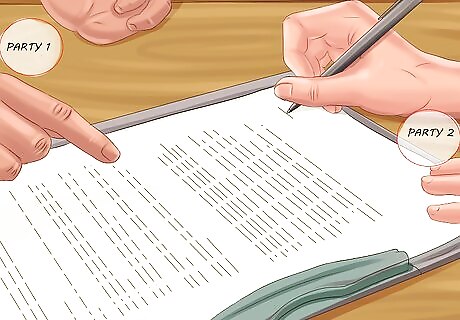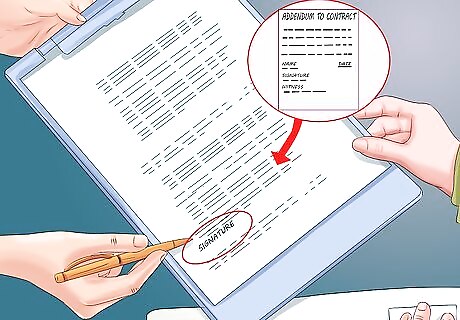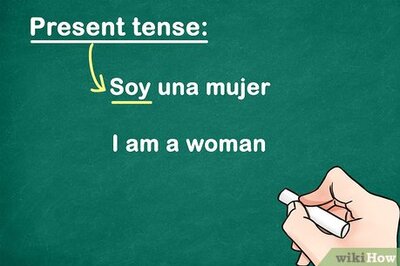
views
Negotiating a Change

Determine whether direct negotiation is allowed. In some cases, employers and employees are not able to directly negotiate or renegotiate employment contracts. In the case of members of a recognized union, all contracts are subject to a collective bargaining agreement. The terms of employment for all members subject to the agreement can only altered after negotiation with the union.

Approach the other party involved. No party can unilaterally change an employment contract. Therefore, if you want to change any terms in your employment contract, you should approach the other party. Inquire about whether they would be open to changing the terms of the contract, and what the best means of changing the contract are. If you are an employee, you could start by contacting your company’s human resources department or contacting your boss directly. If you are the employer, you should approach your employee or have human resources approach them.

Understand the priorities of both sides. Determine your own goals. Before you negotiate you must identify your primary and secondary goals. If your primary goal is a salary increase, you may be willing sacrifice some of secondary goals in the negotiations. It is also important to identify who will be making the final decision regarding your contract. Try to find out what they value most. You should also understand the primary reasons why people choose to renegotiate contracts. Here are a few examples: Underpayment or overpayment of the employee based on the market. Heightened employee responsibilities. Different job responsibilities than the ones that are set out in the current contract. The level of employee performance. Changes in the education or experience level of the employee.

Negotiate the change. Re-negotiating your contract can be a difficult and uncomfortable situation for employees and employers. If the re-negotiation is not successful, the employee may either be stuck with an unsatisfactory contract or look for employment elsewhere. The employer may be forced to work with an employee who is extremely unhappy. Try to be flexible with your goals. It’s possible that the other party may come up with options that you did not think about beforehand. Don’t dismiss their suggestions out of hand. Listen! While you are negotiating, listen to what the other party is saying. If you listen carefully it will be easier to figure out what the other party is willing to give you. Be realistic. You need to have as much information as possible when you go into the contract negotiation so that your goals are realistic. You need to be able see the negotiation from both sides. Understand what the other side's primary goals and motivations are. Make allies. Oftentimes, other employees will be willing to advocate on your behalf if you are doing a good job. This may be especially true if you are not re-negotiating your contract with an immediate supervisor. Be professional. No yelling, screaming or crying. Calmly explain why you have earned a new contract. Use evidence. Bring in evidence that explains why you deserve a new contract. If necessary, use charts and graphs to show how you have increased sales, productivity, etc. Don’t be afraid to make the case that you have done a good job and are an asset to your company. If you have a better offer from another company, use that as leverage. You will be able to make a credible argument that this is what your skills are worth on the open market. You need to explain that you would rather stay with your current employer, but that you are willing to move to a new company to be paid what you are worth. (Don’t bluff in this situation. If you have no desire to leave, don't threaten to do so.) Don’t box yourself into a corner. Try to avoid issuing ultimatums. If you issue an ultimatums you leave yourself exposed. Try to propose alternative solutions that give you an escape hatch. If you successfully renegotiate your contract be grateful and magnanimous. Thank them for your new contract and be respectful.

Make sure the negotiations are valid under the law of contracts. An employment contract must comply with the applicable contract laws in order to be valid. The same is true for any changes to the contract. To make sure any changes to your employment contract comply with the law consider the following: The law of contracts requires that changes to a contract are supported by "consideration." To give consideration just means to agree to do or not do something. In contracts, it is understood that some kind of exchange is being made. In a legal contract, each side is providing some kind of benefit to the other. As an example, when an employer offers to pay an employee a larger salary in return for the employee working longer hours than the original contract specified, the parties have each given consideration (employer = more money; employee = longer hours). Make sure that any changes are memorialized in a written addendum or a new contract. Employment contracts that specify a duration of longer than a year are required to be in writing. All parties to the change may write down the change in an entirely new contract or, you may add an addendum to the current contract. If any of the modifications to the contract conflict with the current terms of the contract, you cannot use an addendum. You instead must execute a new contract. However, if the changes do not contradict the current terms of the contract, you may instead want to use an addendum.
Adding an Addendum to Change a Contract

Determine if an addendum is necessary. An addendum to a contract leaves the original contract in full force and effect. It only adds the specific terms described in the addendum. Therefore, you can only choose to add an addendum to the contract if the changes do not conflict with the original contract. Rereading the contract in its entirety is the first step in making an attempt to change the contract. Specifically, you should look for any references to provisions for changing the contract. In particular, look for a modification clause that outlines how changes can be made. If no specific directions for modifying a contract are given, you will need to add an addendum or write a new contract.

Reference the original employment contract in the addendum. The addendum should reference the original employment document by its title and the date that it was originally drawn and signed. This helps to ensure that is it clear which contract is being modified. Let's say the original Employment Contract was titled “Employment Agreement”, and it was signed by the parties on May 9, 2015. Your addendum should include a statement that the document is an addendum to the parties' Employment Agreement of May 9, 2015.

Name the parties to the contract. For example, if ABC Enterprises is the employer and Jane Smith is the employee, the addendum should clearly state that the original contract was made between ABC Enterprises and Jane Smith. After naming a party for the first time, you should include in parentheses the name by which the remainder of the contract will refer to him or her. For example, you may include a statement such as, “this Addendum (“Addendum”) is a modification of the Employment Agreement (“Agreement”) between ABC Enterprises (“Employer”) and Jane Smith (“Employee”) which is dated May 9, 20015.”

Describe the terms of the addendum. Clearly and concisely state the specific terms of the original contract that are to be changed. The terminology and formatting should be presented in a way that makes the addendum easy to read and understand. Take care to ensure there is no confusion as how the addendum changes the original contract: Use strikethrough and bold font to clarify additions and deletions. For example, “the original text of Item I of the original Employment Contract would go here and any words you wanted wish to delete would be stricken with a strikethrough while any words you want to add would be put in bold type.” Specify whether an item replaces a current item in the contract, changes one, or is a new item. For example, “Item I of the Employment Contract shall be modified as follows with the text in bold added to the Item and the text containing a strikethrough deleted.” Attach the original contract to the addendum, and reference the fact that you have done so in your Addendum. For example, “the original Employment Contract dated May 9, 2007 is attached and made a part of this document.” This ensures that all parties signing the addendum are clear about which contract the addendum changes.

Add a signature block to the addendum. The signature block should contain a blank space for the date the addendum is executed or signed, a line for each party to sign, and each party’s typed or printed name.
Changing a Contract of Employment with No Modification Clause

Understand how courts can modify employment contracts. In some limited situations, courts will modify the terms of an employment contract. Some reasons that a court may modify the terms of an employment contract are: Non-compete Agreements. Courts will sometimes modify contracts that contain very restrictive non-compete agreements. For example, if an employment contract states that the employee “may not take work in the same field anywhere in the United States for a period of 20 years,” a judge may alter it. The court would probably modify that portion of the contract to instead read the employee “may not work in the same field within 5 miles of the location of the current employment for a period of 12 months.” Fraud. Fraud occurs when a party intentionally makes a false statement regarding a matter of fact upon which the other party relies and as a result is injured. If a party fraudulently represents something regarding employment (such as employee ability or hours required), the court could modify the contract or allow the injured party to get out of the contract. Duress. If the court finds that the employer or the employee was threatened into signing the contract, it can be rescinded or modified to reflect more favorable terms.

Know how contracts can be terminated "at will" in some places. Some states allow for “at will” employment. In those cases, either the employer or the employee may terminate the employment for any legal reason at any time. Where permitted, they contract can be terminated without penalty. If you live in an "at will" employment state, you may be able to terminate the current employment contract and make a new offer that includes the changed terms.

If the two parties cannot come to an agreement modifying an existing contract, the employer may fire the employee, or the employee may quit the job. However, this could subject the party that “breaches” the contract to legal consequences. The precise consequences depend on the language of the contract and whether it provides for early termination of the contract. Unless it is allowed by the existing contract, an employee may sue an employer who fired them for refusing to sign a new contract. On the other hand, an employee who terminates a contract because the employer will not modify the terms, the employee can be sued for breach of contract.




















Comments
0 comment